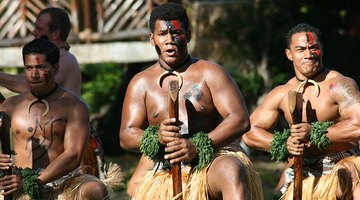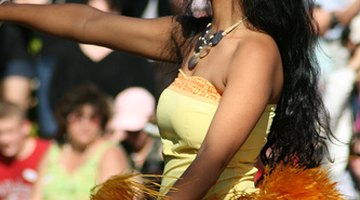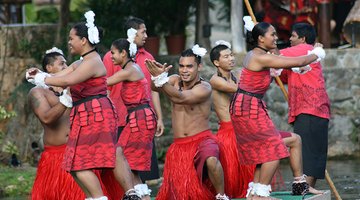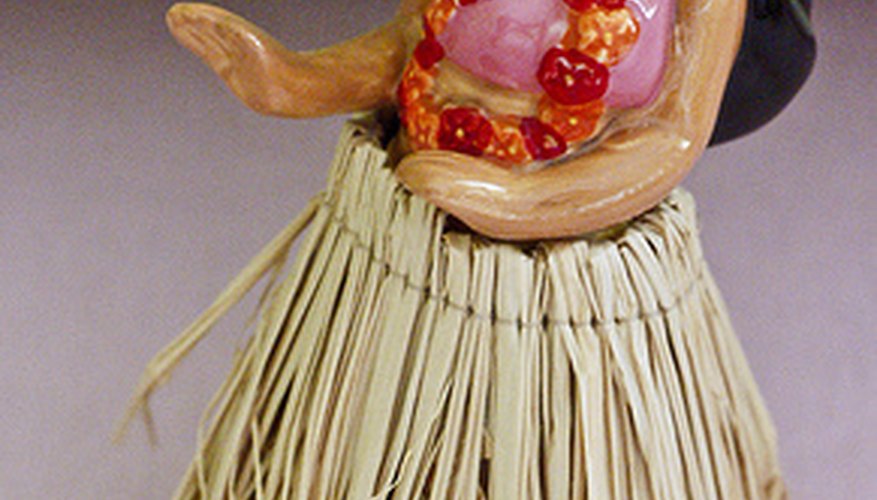Grass skirts often come to mind when Hawaii is mentioned. Hawaiians have shared certain aspects of their culture, including the hula, with the world. Many people wear a hula costume for Halloween or parties, but few people question what the grass hula skirt is, what it means and how it's changed over time.
History
Hula has been a Hawaiian tradition for centuries. The early Hawaiians did not document or record the origin of hula, but the Polynesians had been dancing the hula during celebrations and rituals for centuries by the time Captain Cook arrived on the islands in the 1770s. The Hawaiian culture, including hula, was forever changed by the Westerners.
Missionaries arrived in the 1830s and were appalled by the dancing, which was stopped in the cities until King Kalakaua's reign during the 1870s, when hula became a part of the Hawaiian culture again.
- Hula has been a Hawaiian tradition for centuries.
- Missionaries arrived in the 1830s and were appalled by the dancing, which was stopped in the cities until King Kalakaua's reign during the 1870s, when hula became a part of the Hawaiian culture again.
Hula troupes began travelling the world during the early 20th century, sharing their dance. During World War II, soldiers stationed in Hawaii would send home hula girl statues and ornaments. These events led to the widespread fascination with Hawaii's hula dancers.
Time Frame
Men and women were topless in the original hula uniform. Women wore a Pau, which is a wrap made of tapa cloth. Men wore malos, or loincloths. Hula costumes were embellished with leis and decorations for dancers' wrists and ankles. Originally, these decorations were made of whale bone or dogs' teeth. Flowers now are hula dancers' accessories.
- Men and women were topless in the original hula uniform.
- Originally, these decorations were made of whale bone or dogs' teeth.
Significance

The grass skirt was born during the 1800s. Labourers from the Gilbert Islands first introduced the grass skirts, which have evolved over time. The hula costume was of great importance because the hula consisted of more than 300 dances, each with its own meaning. Chants or storytelling often accompanied the hula dances, as a way of telling stories or praising the gods. Men and women both performed hula dances, albeit separately.
- The grass skirt was born during the 1800s.
- The hula costume was of great importance because the hula consisted of more than 300 dances, each with its own meaning.
Types

Grass skirts were once made with ti leaves. They were wider than the modern strands of grass seen in hula skirts. Skirts can be made from different materials now, including raffia, cellophane or lauhala, dried hala leaves. Skirts were traditionally green or brown, but they can be dyed any colour the hula dancer chooses.
- Grass skirts were once made with ti leaves.
- Skirts can be made from different materials now, including raffia, cellophane or lauhala, dried hala leaves.
Size
Hula dancers wear skirts in various lengths, from about the knee down to the ankles. Some materials, such as dried grass or leaves, cause the skirt to be stiff and rest away from the body. Material grass skirts typically lay against the body.
Function
Grass skirts function as the international symbol for hula dancing. Dancers adorn their grass skirt costumes for performances and ritualistic dances. The grass skirts sway with the dancer as she moves her hips, creating a fluid movement.
Considerations

Modern hula dancers don't always wear grass skirts to perform. You can find them wearing cotton dresses, skirts or shirts in bright patterns. These costumes typically hug the dancers' bodies, allowing spectators to see the movement as well as the dancers' hands. Cotton is also more comfortable to dance in than dried leaves and grass.
- Modern hula dancers don't always wear grass skirts to perform.
